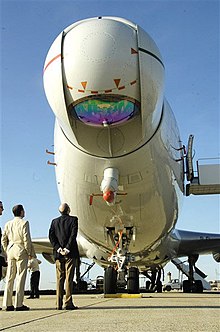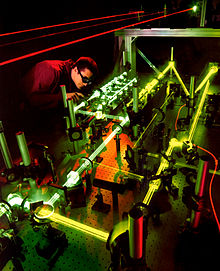Boeing YAL-1
The Boeing YAL-1 Airborne Laser (ABL) weapons system is a megawatt-class chemical oxygen iodine laser (COIL) mounted inside a modified Boeing 747-400F. It is primarily designed to destroy tactical ballistic missiles (TBMs), similar to the Scud, while in boost phase. The low-power lasers have been test-fired in flight, aimed at an airborne target board.[1] The aircraft was designated YAL-1A in 2004 by the U.S. Department of Defense.[2] The Airborne Laser Laboratory, a less-powerful prototype installed in a Boeing NKC-135A, shot down several missiles in the 1980s.[3]
Overview

The ABL doesn't burn through or disintegrate its target. It heats the missile skin, weakening it, causing failure from high speed flight stress. If proven successful, seven ABL-armed 747s will be built. They will be assigned to two combat theaters.
The aircraft were originally slated to enter service in 2008, but development has been slower and costlier than planned. The current plan calls for a prototype ABL to attempt to shoot down a test missile in 2009. [4] Data acquired in the test will shape the final production design, which is now expected to enter service several years from now.
The plan has been for the MDA and the Air Force to develop two prototype aircraft. The Air Force would then take over subsequent development.
Use against ICBMs vs TBMs

The ABL was designed for use against tactical ballistic missiles. TBMs have a shorter range and fly slower than ICBMs. The MDA has recently suggested the ABL might be used against ICBMs during their boost phase. This could require much longer flights to get in position, and might not be possible without flying over hostile territory. Liquid-fueled ICBMs, which have thinner skins, and remain in boost phase longer than TBMs, might be easier to destroy.
If the ABL achieves its design goals, it could destroy liquid-fueled ICBMs up to 600 km away. Tougher solid-fueled ICBM destruction range would likely be limited to 300 km, too short to be useful in many scenarios, according to a 2003 report by the American Physical Society on National Missile Defense. [5]
Intercept sequence
The ABL system uses infrared sensors for initial missile detection. After initial detection, three low power tracking lasers calculate missile course, speed, an aimpoint, and air turbulence. Air turbulence deflects and distorts the laser beam. The ABL adaptive optics use the turbulence measurement to compensate for atmospheric errors. The main laser, located in a turret on the aircraft nose, is fired for 3 to 5 seconds, causing the missile to break up in flight near the launch area. The ABL is not designed to intercept TBMs in the terminal, or descending, flight phase. Thus, the ABL must be within a few hundred kilometers of the missile launch point. All of this occurs in approximately 8 to 12 seconds.
Operational considerations

The ABL uses chemical fuel similar to rocket propellant to generate the high laser power. Current plans call for each 747 to carry enough laser fuel for about 20 shots, or perhaps as many as 40 low-power shots against fragile TBMs. The ABL aircraft must land to refuel the laser. Preliminary operational plans call for the ABL to be escorted by fighters and possibly electronic warfare aircraft. The ABL aircraft would likely orbit near potential launch sites for long periods, flying a figure-eight pattern that allows the aircraft to keep the laser aimed toward the missiles. The aircraft can be refueled in flight, enabling it to stay aloft for long periods.
Use against other targets
In theory, the ABL could be used against hostile fighter aircraft, cruise missiles, or even low-earth-orbit satellites (see Anti-satellite weapon). However, as they are not its intended target, the capability against them is unknown. The ABL infrared target acquisition system is designed to detect the hot exhaust of TBMs in boost phase. Satellites and other aircraft could have a much lower heat signature and possibly be harder to detect. This analysis by the Union of Concerned Scientists discusses potential ABL use against low earth orbit satellites. [6]
Use against ground targets seems unlikely. Aside from the difficulty of acquiring and tracking a ground target, firing through the dense atmosphere would weaken the beam. Ground targets such as armored vehicles are not fragile enough to damage with a megawatt-class laser. Another program, the Advanced tactical laser envisions air-to-ground use of a megawatt-class laser mounted on an aircraft better suited for low altitude flight.
COIL
The heart of the system is the COIL, comprised of six interconnected modules, each as large as an SUV turned on-end. Each module weighs about 6,500 pounds (3,000 kg). When fired, the laser produces enough energy in a five-second burst to power a typical American household for more than an hour.[7]
Development


The program was initiated by the Air Force in 1996 with the awarding of a product definition risk reduction contract to Boeing's ABL team. [8][9] In 2001, the program was transferred to the MDA and converted to an acquisition program.[9]
The development of the system is being accomplished by a team of contractors. Boeing Integrated Defense Systems provides the aircraft, the management team and the systems integration processes. Northrop Grumman is supplying the COIL, and Lockheed Martin is supplying the nose turret and the fire control system.[9][7]
In 2001, a retired Air India 747-200 was acquired by the Air Force, and trucked without its wings from the Mojave Airport to Edwards Air Force Base where the airframe was incorporated into the System integration Laboratory (SIL) building at Edwards' Birk Flight Test Center, to be used to fit check and test the various components.[10][11] The SIL was built primarily to test the COIL at a simulated operational altitude, and during that phase of the program, the laser was operated over 50 times, achieving lasing durations representative of actual operational engagements. These tests fully qualified the system so that it can be integrated into the actual aircraft. Following the completion of the tests, the laboratory is being dismantled, and the 747-200 fuselage is being removed.[11]
Boeing completed initial modifications to the 747-400F in 2002, culminating in its first flight on July 18, 2002 from Boeing's Wichita, Kansas facility. Ground testing of the COIL resulted in its successful firing in 2004. The YAL-1 was assigned to the 417th Flight Test Squadron Airborne Laser Combined Test Force at Edwards.
Besides the COIL, the system also includes two kilowatt-class Target Illuminator Lasers for target tracking. On March 15, 2007, the YAL-1 successfully fired this laser in flight, hitting its target. The target was an NC-135E Big Crow test aircraft that has been specially modified with a "signboard" target on its fuselage. The test validated the system's ability to track an airborne target and measure and compensate for atmospheric distortion.[7]
The next phase in the test program involves the "surrogate high-energy laser" (SHEL), a stand-in for the COIL, and will demonstrate the transition from target illumination to simulated weapons firing. Later in 2007, the COIL will be installed in the YAL-1 and tested.[7]
See also
Related development
Aircraft of comparable role, configuration, and era
Related lists
References
- ^ Airborne Laser returns for more testing
- ^ DoD 4120.15-L, Model Designation of Military Aerospace Vehicles, U.S. Department of Defense, May 12, 2004.
- ^ FAS Airborne Laser Laboratory news
- ^ U.S. Missile Defense Agency Budget Funds ABL
- ^ APS Study
- ^ Anti-Satellite Capabilities of Planned US Missile Defense Systems
- ^ a b c d Grill, Eric M., "Airborne Laser fires tracking laser, hits target", Aerotech News and Review, March 23, 2007, vol 22 issue 8
- ^ Boeing AL Timeline
- ^ a b c Boeing Airborne Laser Background presentation
- ^ Radecki, Alan K. A Mojave Scrapbook, MojaveBooks, 2005
- ^ a b Hernandez, Jason, "Testers end high-energy laser tests, dismantle Airborne Laser SIL facility",USAF press release, March 29, 2007
F. Tarsha-Kurdi, T. Landes, P. Grussenmeyer, E. Smigiel, ”New approach for automatic detection of buildings in airborne laser scanner data using first echo only”. Workshop of the ISPRS. Com III, Photogrammetric computer vision PCV ' 06 Bonn, Germany 20 – 22 September 2006.
External links
- Boeing Airborne Laser web page
- YAL-1A USAF fact sheet
- Airborne Laser MDA fact sheet
- ABL page on fas.org
- YAL-1 ABL page
- ABL and National Missile Defense
- Pentagon Demotes Airborne Laser
- Airborne Laser Laboratory
- An animation depicting the laser interception of a ballistic missile. (AVI format)
